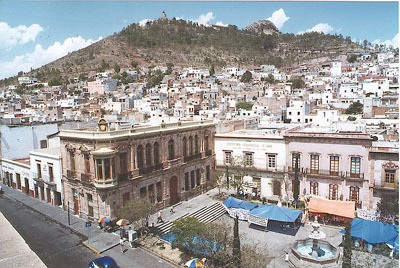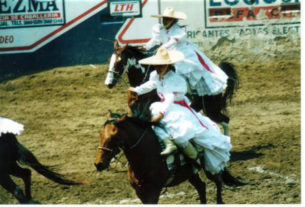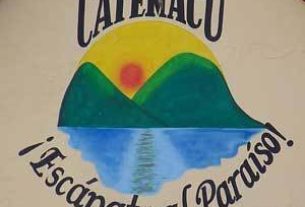
The city of Zacatecas in northern Mexico is not only a veritable labyrinth of winding streets but also a fascinating labyrinth of artistic and cultural treasures.
Built between hills and on steep slopes, Zacatecas (the name is derived from zacatl = grass and tecatl = people) is one of the few Mexican cities to have a maze-like street plan which makes wandering it a delight, even if it is easy to become disoriented!
The people of Zacatecas are especially proud of having preserved and restored so many ancient architectural and artistic monuments that the city was designated a “Cultural Treasure of Humanity” in 1993 by UNESCO. The result is a happy city, with relatively few above-ground utility poles and no billboard advertising in the historic center.
The following is a suggested self-guiding walking tour of the city center, beginning from the main plaza, by the Cathedral..
The Cathedral was built between 1730 and 1760. The facade, depicting Christ and the 12 apostles, is one of the finest examples of Churrigueresque architecture in Mexico. The rosette window in the center shows especially masterful carving. Inspired by the Holy Trinity, the cathedral has 3 naves, 3 doorways, 3 levels on the main facade with 3 columns defining the niches. The interior of the cathedral is nowhere near so spectacular, though in former times it included a font of solid silver, donated by a local countess.
The main square, or Plaza de Armas, has surprisingly few trees or flowers due to the difficult climate. On its south side is the State Government Palace, an eighteenth century building, originally the dwelling of the Count of Santiago de la Laguna.
Across the main street and on the left as you stand with your back to the Government Palace is the Palacio de la Mala Noche, (The Bad Night Palace), the house of a Spanish miner, Manuel de Rétegui. The discovery of the mine which brought vast, if quickly spent, wealth to the owner, occurred just as he was on the point of committing suicide. Almost next to the Bad Night Palace is the former Hotel Frances, now a tourist information office.
Several blocks walk along Hidalgo Avenue to the east is the former convent of San Francisco, dating from the seventeenth century, now the Rafael Coronel museum with many fine collections including a world-class collection of masks and a display of nineteenth century puppets. (Closed Wednesdays).
Returning towards the center, but on the street above Hidalgo avenue, brings us to the Plaza de Santo Domingo. The church of Santo Domingo, built as a Jesuit church (1746-9) but turned over to the Dominicans when the Jesuits were expelled in 1767, has a particularly interesting interior with 8 Churrigueresque gilded wooden “retablos” or altarpieces, with fine sculptures and paintings.
On the north side of the plaza is the former Jesuit College, now the Pedro Coronel museum displaying this Zacatecan painter’s fabulous collection of art from around the world, donated near the end of his life to his native city. Coronel’s collection has been described as a “unique example of its kind in Mexico, indeed in all Latin America.” The ground floor houses the Elías Amador Library, some 25,000 volumes full of history. The building was at various times in its history a Jesuit college, a Dominican convent, military headquarters and a gaol, before becoming a museum in 1984.
Two short blocks away is the former Casa de la Moneda (Royal Mint), founded in 1810, which later became the State Treasury and is now the Zacatecan Museum, with collections of Huichol Indian art, votive paintings and ironwork.
Continuing on Ignacio Hierro street past the Zacatecan museum, a magnificent doorway greets us on our right. This is the side entrance to the ex-temple of San Agustín. Its main facade was destroyed in the last century and its towers decapitated. The carving on the side doorway represents the dream of Saint Augustine who is shown reclining on his right arm, book in left hand, below olive and cypress trees.
Downhill from San Agustin is the Rosales Arcade, once an important shopping area. Turning back towards the Cathedral brings us to the Fernando Calderón Theater, constructed between 1891 and 1897 and which takes its name from Fernando Calderón (1809-1845), a noted poet and dramatist. Across the street from the theater is the nineteenth century González Ortega Market, completely remodelled in 1982 as a shopping center. This is a good place to look for souvenirs, and below the market (entrances on Tacuba street) are several very good and inexpensive restaurants.
Using the Cathedral as our landmark, we didn’t even get lost!
Among fun places to visit with children in Zacatecas are the El Eden mine, where a narrow-gauge mining train takes visitors into the depths below the city and the cable-car or teleferico which soars over the city from one of the mine’s upper entrances to the La Bufa hill with its outstanding view over everything. La Bufa has an equestrian statue of Francisco “Pancho” Villa commemorating June 23, 1914, when he and his troops successfully took the city after a nine-hour battle.
If your visit coincides with the three days ending on the final Sunday in August, then don’t miss – La Morisma – a colorful re-enactment of the Moors meet the Christians in the hills above the village of Bracho. The costumes are spectacular.
In the suburbs of Zacatecas is the village of Guadalupe, once the base for the great Franciscan drive northwards. The former monastery is now the Museum of Viceregal Art, a treasure trove of secret passages, cells, catacombs, sundials, enormous water tanks, chapels, corridors and doorways, together with magnificent pieces of religious art of all kinds. Highlights include seventeenth century oil paintings in which the subject’s eyes seek out the viewer regardless of the angle from which he or she tries to evade the saint’s scrutiny, cells furnished in period style, the monastery library and the Nápoles Chapel, richly decorated with complicated white and gold motifs.
Labyrinthine, Zacatecas may be, but the effort to explore its narrow, winding streets is more than repaid by the discovery of so many cultural and artistic riches.


